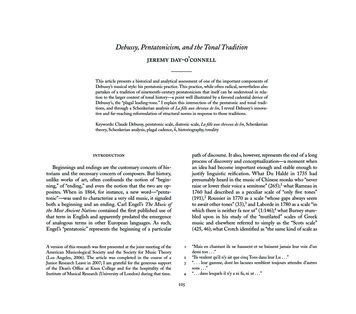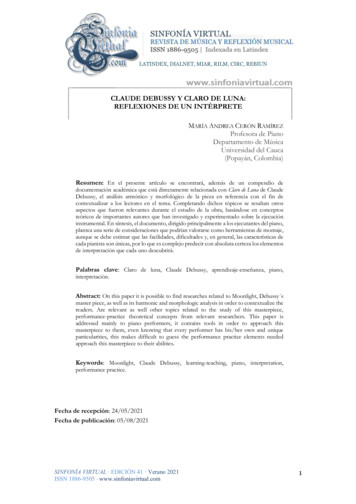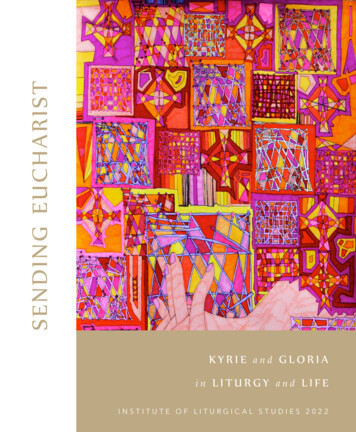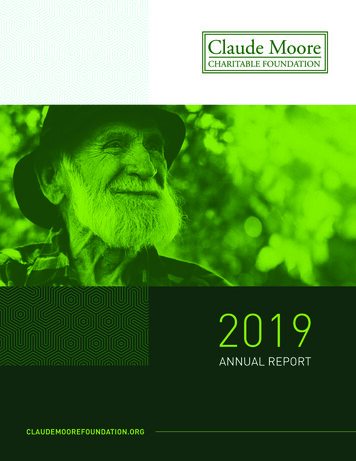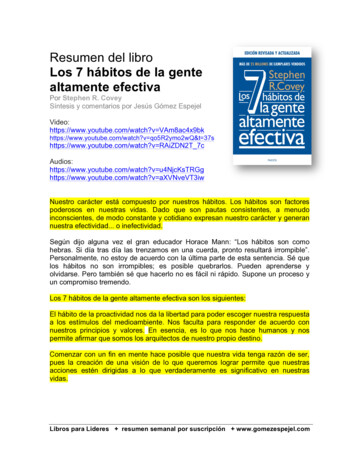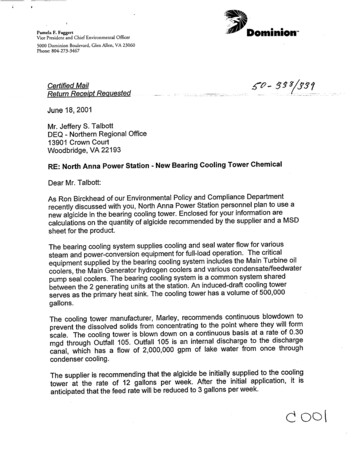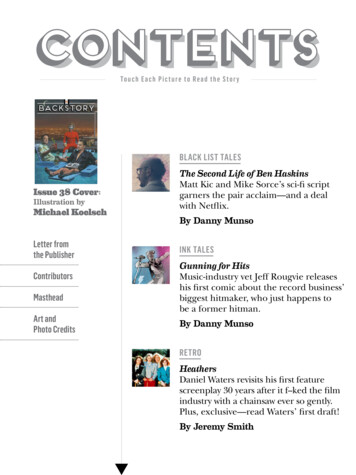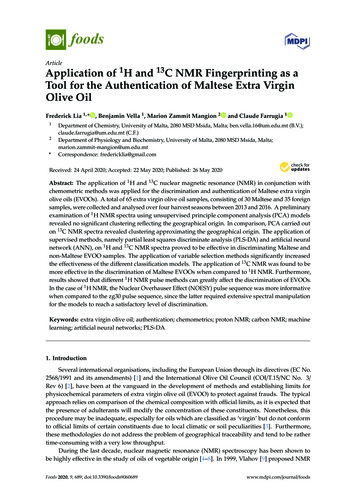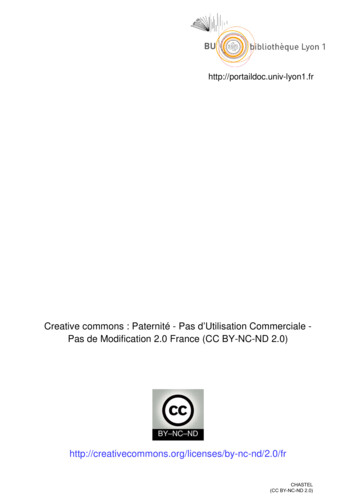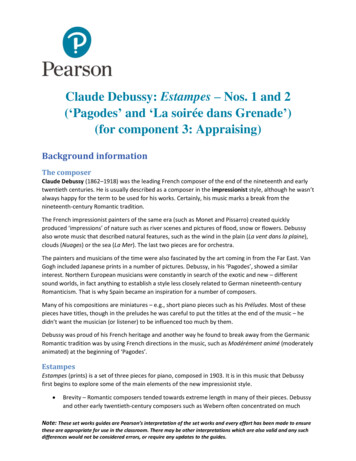
Transcription
Claude Debussy: Estampes – Nos. 1 and 2(‘Pagodes’ and ‘La soirée dans Grenade’)(for component 3: Appraising)Background informationThe composerClaude Debussy (1862–1918) was the leading French composer of the end of the nineteenth and earlytwentieth centuries. He is usually described as a composer in the impressionist style, although he wasn’talways happy for the term to be used for his works. Certainly, his music marks a break from thenineteenth-century Romantic tradition.The French impressionist painters of the same era (such as Monet and Pissarro) created quicklyproduced ‘impressions’ of nature such as river scenes and pictures of flood, snow or flowers. Debussyalso wrote music that described natural features, such as the wind in the plain (La vent dans la plaine),clouds (Nuages) or the sea (La Mer). The last two pieces are for orchestra.The painters and musicians of the time were also fascinated by the art coming in from the Far East. VanGogh included Japanese prints in a number of pictures. Debussy, in his ‘Pagodes’, showed a similarinterest. Northern European musicians were constantly in search of the exotic and new – differentsound worlds, in fact anything to establish a style less closely related to German nineteenth-centuryRomanticism. That is why Spain became an inspiration for a number of composers.Many of his compositions are miniatures – e.g., short piano pieces such as his Préludes. Most of thesepieces have titles, though in the preludes he was careful to put the titles at the end of the music – hedidn’t want the musician (or listener) to be influenced too much by them.Debussy was proud of his French heritage and another way he found to break away from the GermanicRomantic tradition was by using French directions in the music, such as Modérément animé (moderatelyanimated) at the beginning of ‘Pagodes’.EstampesEstampes (prints) is a set of three pieces for piano, composed in 1903. It is in this music that Debussyfirst begins to explore some of the main elements of the new impressionist style. Brevity – Romantic composers tended towards extreme length in many of their pieces. Debussyand other early twentieth-century composers such as Webern often concentrated on muchNote: These set works guides are Pearson’s interpretation of the set works and every effort has been made to ensurethese are appropriate for use in the classroom. There may be other interpretations which are also valid and any suchdifferences would not be considered errors, or require any updates to the guides.
smaller pieces. Melodies were often short – e.g., the two-bar melody at the beginning of‘Pagodes’.Descriptive music – all three pieces have descriptive titles: ‘Pagodes’ (‘Pagodas’), ‘La soirée dansGrenade’ (‘An Evening in Granada’) and Jardins sous la pluie’ (‘Gardens in the rain’). The music isnever precisely descriptive. The titles are a starting point for the musical style.You will notice the use of pentatonic and modal melodies inspired by Eastern music andWestern folk elements.Tonal schemes that avoid the sense of tonic and dominant chords and traditional modulation.The whole idea of traditional key is avoided. Nevertheless, the music tends to be more diatonicthan other early twentieth-century music. The music is much less chromatic than for instancethe music of Schoenberg.Parallel chords.Use of the sustaining pedal on the piano to produce misty, watery effects.‘Pagodes’Debussy was profoundly influenced by the Javanese gamelan music he heard at the great internationalexhibition of 1899. He recreates some of the aspects of the oriental style he absorbed on that and lateroccasions: The opening contains gong-like open fifths. Gongs are essential gamelan instruments.The chords also feature added notes, e.g. the G added sixth, right hand bar 1, avoidingstraightforward triads and recreating gamelan harmonies.Melodies are influenced by the pentatonic scale, such as the Javanese slendro scale. Theostinato theme in bars 3–4 only uses four different notes. The melody here is equivalent towhat might be played on the metallophones of a gamelan ensemble.Speeds vary during a piece as they do in gamelan music.StructureThe piece is in a loose ternary form, though the central section has elements from the first one, andeach of the three sections has a number of subsections.Main sectionBars 1–32The music begins with a two-bar introduction which sets the oriental scenewith gong-like sounds, produced by low-pitched open fifths and added noteharmonies. The pianist needs to cross hands to play the notes, with the lefthand rising above the right. (m.g. main gauche)The ‘gong’ sounds continue as a type of pedal for the first ten bars, whenthey are replaced by a single low G .The key signature of five sharps suggests B major or G minor but neitherkey is properly established. Debussy is using the black notes of the piano fortheir pentatonic possibilities. B is a tonal centre at the beginning rather thana key.Note: These set works guides are Pearson’s interpretation of the set works and every effort has been made to ensurethese are appropriate for use in the classroom. There may be other interpretations which are also valid and any suchdifferences would not be considered errors, or require any updates to the guides.
A two-bar pentatonic-style melody begins in bar 3 and is then used as anostinato. This melody actually contains only four pitches – C , D , F and G .A three-note figure is played three times in the second of these bars, up anoctave each time. The first two notes are then repeated as part of a triplet.When the melody is repeated at bar 5, the harmonies change subtly, withthe addition of a flat seventh A [natural] above the bass B. Then at bar 7there is an undulating scalic countermelody in the middle of the texture,repeated at bar 9.As the bass changes to G in bar 11, there are two new ideas. A pentatonicidea using all five notes now is played in octaves in the left hand, while aseparate idea closely related to the ostinato motif is played in octaves in theright hand.There is new music at bar 15. A new rumbling triplet ostinato figure starts inthe left hand using just two pitches, like a slow trill. An oriental-style melodyin simple rhythmic style produces cross-rhythms with the left-hand triplets –two against three (bar 16).At bar 19 the idea from the left hand of bar 11 returns in octaves at the topof the texture, with the triplet ostinato now in octaves as well. The music is alittle faster (animez un peu). The bass gradually descends.At bar 23 the bass reaches low B again, while the two hands explore versionsof the four-note idea from bar 11 in contrary motion.B sectionBars 33–52A section (varied)Bars 53 to the endThe sustaining pedal is held on throughout the next four bars, while theright hand plays triplets in two-part harmony, producing chords of fourthsand fifths, always avoiding tonal thirds. The last two bars of the sectionreproduce the harmonies from the beginning.The two-note syncopated chords in seconds from the end of the A sectioncontinue as a linking feature while a new melody explores a whole-tonescale. This middle section still contains many elements from the A section,including a new version of the melody from bar 11 (in the left hand of bar37). The music gradually builds to a fortissimo climax in bar 41 with thetheme from bar 11 in parallel harmonies, with left and right hands playingthe same music two octaves apart.The whole-tone melody returns in bar 46, this time in the left hand. Themelody is repeated while the accompaniment dissolves into trills (bar 50)and the tempo slows.The opening music then returns, without the two-bar introduction. Themusic rises to another climax in bar 73, as in the central section, using thesame melodic material.Note: These set works guides are Pearson’s interpretation of the set works and every effort has been made to ensurethese are appropriate for use in the classroom. There may be other interpretations which are also valid and any suchdifferences would not be considered errors, or require any updates to the guides.
At bar 78 a new rippling ostinato figure starts in demisemiquavers at a hightessitura in the right hand. This is used as an accompaniment to the maintune in the left hand in the middle of the texture at bar 80. Thecountermelody from bar 7 reappears at bar 84.The dynamics become ever quieter (encore plus pp, bar 91) – ‘still morepianissimo’. The bass descends to a bottom octave B as the music is marked‘as quiet as possible’. The instruction at the end is to allow the notes tocontinue vibrating, until the sound evaporates, by keeping the sustain pedaldepressed.‘La soirée dans Grenade’IntroductionDebussy had only once made a very brief journey to Spain – just across the border to San Sebastian.Nevertheless, like other French composers before him, he was attracted to the exoticism of Spanishculture. The title of the piece means ‘Evening in Granada’. Granada is a town in southern Spain, in anarea where centuries ago Moorish invaders from Morocco in north Africa had settled. Their influenceremains to this day in architecture and music.HabaneraThe rhythm of the piece is based on the habanera, originally a Cuban dance – its name refers to theCuban capital Havana. The habanera spread to southern Spain in the nineteenth century and it is still apopular dance there today. The nineteenth-century French composer Bizet uses it in a famous section ofhis opera Carmen.Debussy refers to it in his instructions at the beginning (Mouvement de Habañera) – ‘habanera tempo’.The dance is in simple duple time and has a distinctive rhythm of dotted quaver, semiquaver and twoquavers. Staccato is an essential characteristic of the style, and can be found continuously from bar 5 to16. Often the first note of the rhythm will be low pitched, as in bar 1.The habanera rhythm is present in all of the first 16 bars and makes frequent reappearances in othersections, often with repeated notes as in the bass from bar 23.Guitar soundsThe guitar is the essential instrument of southern Spain and is required for the flamenco dance style ofthe area. Debussy refers to its sounds in the spread chords that are frequently heard in this piece. Thefirst six bars of the Très rhythmé section (from bar 38) all end with a spread chord. The dry sound of therapid staccato spread chord of the flamenco guitar is found at the ends of phrases in the sectionbeginning at bar 17.Moorish songThe melody beginning at bar 7 is like a Moorish lament. It starts with extreme dissonance with theopening D clashing against the C in the right hand. The distinctive augmented second of flamencomusic can be heard in the third bar (B to A). Otherwise the melody is distinctly conjunct. The rhythm isNote: These set works guides are Pearson’s interpretation of the set works and every effort has been made to ensurethese are appropriate for use in the classroom. There may be other interpretations which are also valid and any suchdifferences would not be considered errors, or require any updates to the guides.
extremely fluid, rather like the improvisation that is so important in flamenco style. Note also theacciaccatura ornament in bar 12.Other features of style Parallel chords, a favourite Debussy device, can be heard in various sections of the piece, e.g.from bar 17, where there are parallel seventh chords.Added note chords and chords based on fourths and fifths. The spread chords in the trèsrhythmé section are an example.Frequent changes of tempo. There are four separate tempo markings on the second page of thescore, including rubato (free rhythm), retenu ( rit.), tempo giusto (strict time, back to theearlier tempo), then très rhythmé (‘very rhythmic’) – not necessarily a different tempo, butmusicians often play this section a little faster.Debussy uses a whole-tone scale in bars 24–25 (G-A–B–C –D ).Despite the use of dissonance and chords built on fourths and fifths, some of the music isdistinctly tonal in character. The central melody in octaves beginning at the end of bar 41, aswell as being entirely conjunct, is clearly in A major.Debussy requires cross-hand technique (m.g. m.d.)towards the end of the movement where theMoorish melody returns (bar 122).StructureThe piece is distinctly sectional in style. The many different ideas are all repeated at some stage in thepiece. There is a sense of a very loose ternary structure with the lament melody from bar 7 returningnear the end at bar 122, but it is more complicated than that, with many different ideas.Bars 1–37The music begins with an introduction to the habanera rhythm. Debussyuses extreme ranges of the piano with low octaves in the left hand andhigh octaves in the right. The C pedal continues for six bars beforebecoming an inverted pedal.The Moorish lament begins at bar 7 in what is made to sound like freetime, including triplets (which often create cross-rhythms). Note the use ofthe melodic augmented second at bar 9 and elsewhere. There is acontinuous inverted pedal C – the tonal centre of this section, despite thekey signature of three sharps.A new parallel seventh chord idea starts at bar 17. Each two bar phraseends with a staccato spread chord. There is a C pedal throughout.Two bars of habanera rhythm then lead to a new mainly stepwise idea atbar 23, featuring a whole-tone scale in bars 24–25. This all sounds over arepeated C habanera rhythm in the left hand. Notice that the left hand isin the treble clef, so there is a distinct change in pitch range here.Note: These set works guides are Pearson’s interpretation of the set works and every effort has been made to ensurethese are appropriate for use in the classroom. There may be other interpretations which are also valid and any suchdifferences would not be considered errors, or require any updates to the guides.
The parallel seventh chord idea returns at bar 29, now in a transposedversion over an F pedal. The idea has a new extension at bar 33 withsyncopation and triplets.Bars 38–60A new section marked ‘very rhythmic’ begins at bar 38 with a four-barintroduction. The spread chords at the end of each of the first six bars arebuilt on fourths and fifths with added notes. The tonal centre is now A. Anew tonal melody begins in octaves in the right hand on the upbeat to bar42. The whole melody is built on steps. The habanera rhythm on Acontinues as an ostinato.Bars 61–91At bar 61 the rubato melody from bar 23 returns, again over a C pedal,but this time without the whole-tone scale. There’s an augmented secondinstead.At bar 67 there is a new wide-ranging syncopated theme over an F pedaland habanera rhythm. The key signature changes to F major. There is a Gdouble sharp, which acts as a chromatic appoggiatura to the third of thetonic chord. The occasional flat third A naturals have the effect of a bluenote (e.g. bar 70). The music here is more disjunct (containing manyleaps).At bar 78 a much smoother version of the theme from bar 23 and 61 nowreturns, without the whole-tone scale or augmented second. The dynamicsshow a sudden pianissimo (bar 78). There are continuous parallel triadicchords (built on thirds, without added notes).Bars 92–endThe music from bar 17 then returns again, leading into the theme from bar43, again in A major but with a new parallel chord accompaniment above it(from upbeat to 98), pianissimo. The music moves into three staves, spreadover a wide pitch range, with bottom E pedal notes in the bass.A new, very rhythmic idea starts at bar 109. It is marked as lointain(‘distant’), like a distant murmur of sound in the night air.At bar 113 the wide leaping, syncopated idea from bar 67 reappears butonly for two bars, before the new ‘distant’ idea interrupts briefly, allowingthe syncopated idea to continue for three more bars at bar 119.Finally the lament from just after the beginning makes its only otherappearance. This time there are spread chords below, of A and of thesubdominant D, while the habanera rhythm continues at the top of thetexture. Notice the use of cross-hand technique here.The music gradually dies away at the end.Note: These set works guides are Pearson’s interpretation of the set works and every effort has been made to ensurethese are appropriate for use in the classroom. There may be other interpretations which are also valid and any suchdifferences would not be considered errors, or require any updates to the guides.
Guitar sounds The guitar is the essential instrument of southern Spain and is required for the flamenco dance style of the area. Debussy refers to its sounds in the spread chords that are frequently heard in this piece. The first six bars of the Très rhythmé section (from bar 38) all end with a spread chord. The dry sound of the
